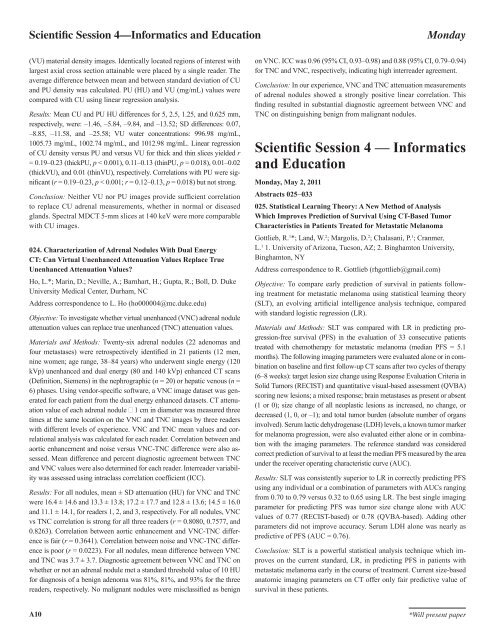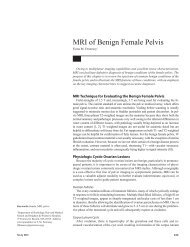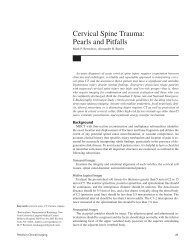Scientific Session 1 â Breast Imaging: Mammography
Scientific Session 1 â Breast Imaging: Mammography
Scientific Session 1 â Breast Imaging: Mammography
You also want an ePaper? Increase the reach of your titles
YUMPU automatically turns print PDFs into web optimized ePapers that Google loves.
<strong>Scientific</strong> <strong>Session</strong> 4—Informatics and EducationMonday(VU) material density images. Identically located regions of interest withlargest axial cross section attainable were placed by a single reader. Theaverage difference between mean and between standard deviation of CUand PU density was calculated. PU (HU) and VU (mg/mL) values werecompared with CU using linear regression analysis.Results: Mean CU and PU HU differences for 5, 2.5, 1.25, and 0.625 mm,respectively, were: –1.46, –5.84, –9.84, and –13.52; SD differences: 0.07,–8.85, –11.58, and –25.58; VU water concentrations: 996.98 mg/mL,1005.73 mg/mL, 1002.74 mg/mL, and 1012.98 mg/mL. Linear regressionof CU density versus PU and versus VU for thick and thin slices yielded r= 0.19–0.23 (thickPU, p < 0.001), 0.11–0.13 (thinPU, p = 0.018), 0.01–0.02(thickVU), and 0.01 (thinVU), respectively. Correlations with PU were significant(r = 0.19–0.23, p < 0.001; r = 0.12–0.13, p = 0.018) but not strong.Conclusion: Neither VU nor PU images provide sufficient correlationto replace CU adrenal measurements, whether in normal or diseasedglands. Spectral MDCT 5-mm slices at 140 keV were more comparablewith CU images.024. Characterization of Adrenal Nodules With Dual EnergyCT: Can Virtual Unenhanced Attenuation Values Replace TrueUnenhanced Attenuation Values?Ho, L.*; Marin, D.; Neville, A.; Barnhart, H.; Gupta, R.; Boll, D. DukeUniversity Medical Center, Durham, NCAddress correspondence to L. Ho (ho000004@mc.duke.edu)Objective: To investigate whether virtual unenhanced (VNC) adrenal noduleattenuation values can replace true unenhanced (TNC) attenuation values.Materials and Methods: Twenty-six adrenal nodules (22 adenomas andfour metastases) were retrospectively identified in 21 patients (12 men,nine women; age range, 38–84 years) who underwent single energy (120kVp) unenhanced and dual energy (80 and 140 kVp) enhanced CT scans(Definition, Siemens) in the nephrographic (n = 20) or hepatic venous (n =6) phases. Using vendor-specific software, a VNC image dataset was generatedfor each patient from the dual energy enhanced datasets. CT attenuationvalue of each adrenal nodule ³ 1 cm in diameter was measured threetimes at the same location on the VNC and TNC images by three readerswith different levels of experience. VNC and TNC mean values and correlationalanalysis was calculated for each reader. Correlation between andaortic enhancement and noise versus VNC-TNC difference were also assessed.Mean difference and percent diagnostic agreement between TNCand VNC values were also determined for each reader. Interreader variabilitywas assessed using intraclass correlation coefficient (ICC).Results: For all nodules, mean ± SD attenuation (HU) for VNC and TNCwere 16.4 ± 14.6 and 13.3 ± 13.8; 17.2 ± 17.7 and 12.8 ± 13.6; 14.5 ± 16.0and 11.1 ± 14.1, for readers 1, 2, and 3, respectively. For all nodules, VNCvs TNC correlation is strong for all three readers (r = 0.8080, 0.7577, and0.8263). Correlation between aortic enhancement and VNC-TNC differenceis fair (r = 0.3641). Correlation between noise and VNC-TNC differenceis poor (r = 0.0223). For all nodules, mean difference between VNCand TNC was 3.7 ± 3.7. Diagnostic agreement between VNC and TNC onwhether or not an adrenal nodule met a standard threshold value of 10 HUfor diagnosis of a benign adenoma was 81%, 81%, and 93% for the threereaders, respectively. No malignant nodules were misclassified as benignon VNC. ICC was 0.96 (95% CI, 0.93–0.98) and 0.88 (95% CI, 0.79–0.94)for TNC and VNC, respectively, indicating high interreader agreement.Conclusion: In our experience, VNC and TNC attenuation measurementsof adrenal nodules showed a strongly positive linear correlation. Thisfinding resulted in substantial diagnostic agreement between VNC andTNC on distinguishing benign from malignant nodules.<strong>Scientific</strong> <strong>Session</strong> 4 — Informaticsand EducationMonday, May 2, 2011Abstracts 025-033025. Statistical Learning Theory: A New Method of AnalysisWhich Improves Prediction of Survival Using CT-Based TumorCharacteristics in Patients Treated for Metastatic MelanomaGottlieb, R. 1 *; Land, W. 2 ; Margolis, D. 2 ; Chalasani, P. 1 ; Cranmer,L. 1 1. University of Arizona, Tucson, AZ; 2. Binghamton University,Binghamton, NYAddress correspondence to R. Gottlieb (rhgottlieb@gmail.com)Objective: To compare early prediction of survival in patients followingtreatment for metastatic melanoma using statistical learning theory(SLT), an evolving artificial intelligence analysis technique, comparedwith standard logistic regression (LR).Materials and Methods: SLT was compared with LR in predicting progression-freesurvival (PFS) in the evaluation of 33 consecutive patientstreated with chemotherapy for metastatic melanoma (median PFS = 5.1months). The following imaging parameters were evaluated alone or in combinationon baseline and first follow-up CT scans after two cycles of therapy(6–8 weeks): target lesion size change using Response Evaluation Criteria inSolid Tumors (RECIST) and quantitative visual-based assessment (QVBA)scoring new lesions; a mixed response; brain metastases as present or absent(1 or 0); size change of all neoplastic lesions as increased, no change, ordecreased (1, 0, or –1); and total tumor burden (absolute number of organsinvolved). Serum lactic dehydrogenase (LDH) levels, a known tumor markerfor melanoma progression, were also evaluated either alone or in combinationwith the imaging parameters. The reference standard was consideredcorrect prediction of survival to at least the median PFS measured by the areaunder the receiver operating characteristic curve (AUC).Results: SLT was consistently superior to LR in correctly predicting PFSusing any individual or a combination of parameters with AUCs rangingfrom 0.70 to 0.79 versus 0.32 to 0.65 using LR. The best single imagingparameter for predicting PFS was tumor size change alone with AUCvalues of 0.77 (RECIST-based) or 0.78 (QVBA-based). Adding otherparameters did not improve accuracy. Serum LDH alone was nearly aspredictive of PFS (AUC = 0.76).Conclusion: SLT is a powerful statistical analysis technique which improveson the current standard, LR, in predicting PFS in patients withmetastatic melanoma early in the course of treatment. Current size-basedanatomic imaging parameters on CT offer only fair predictive value ofsurvival in these patients.A10*Will present paper
















